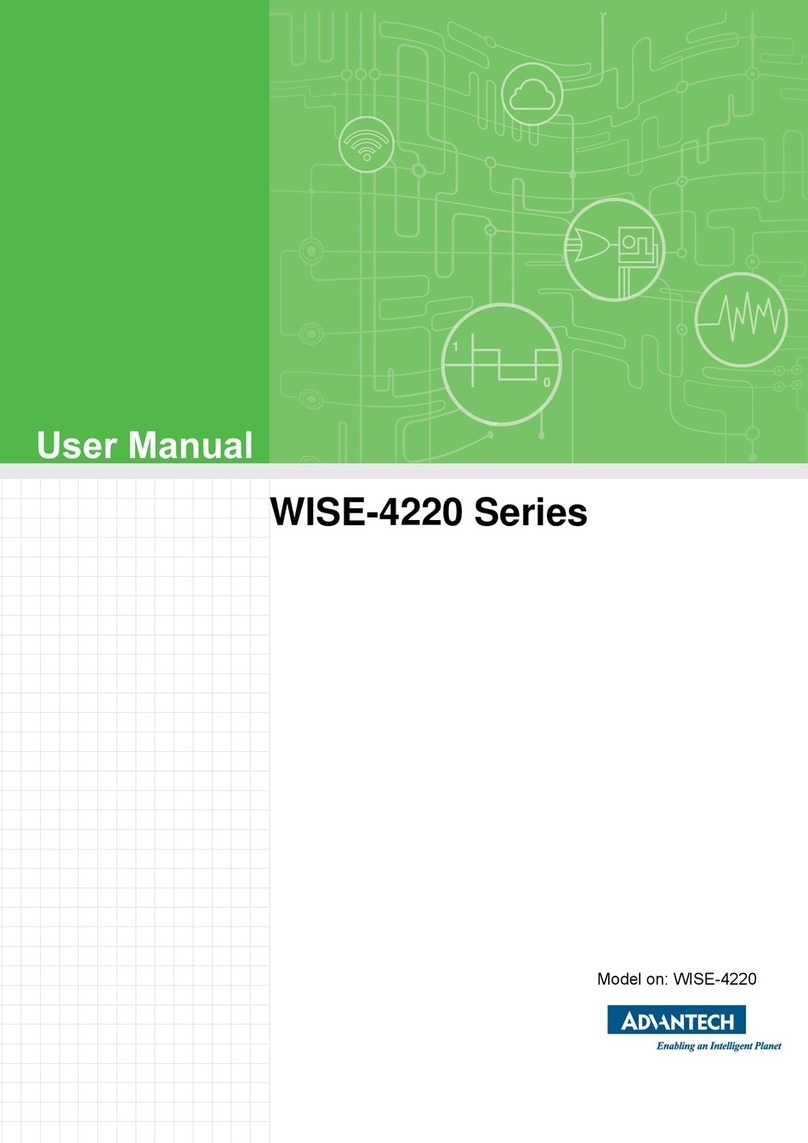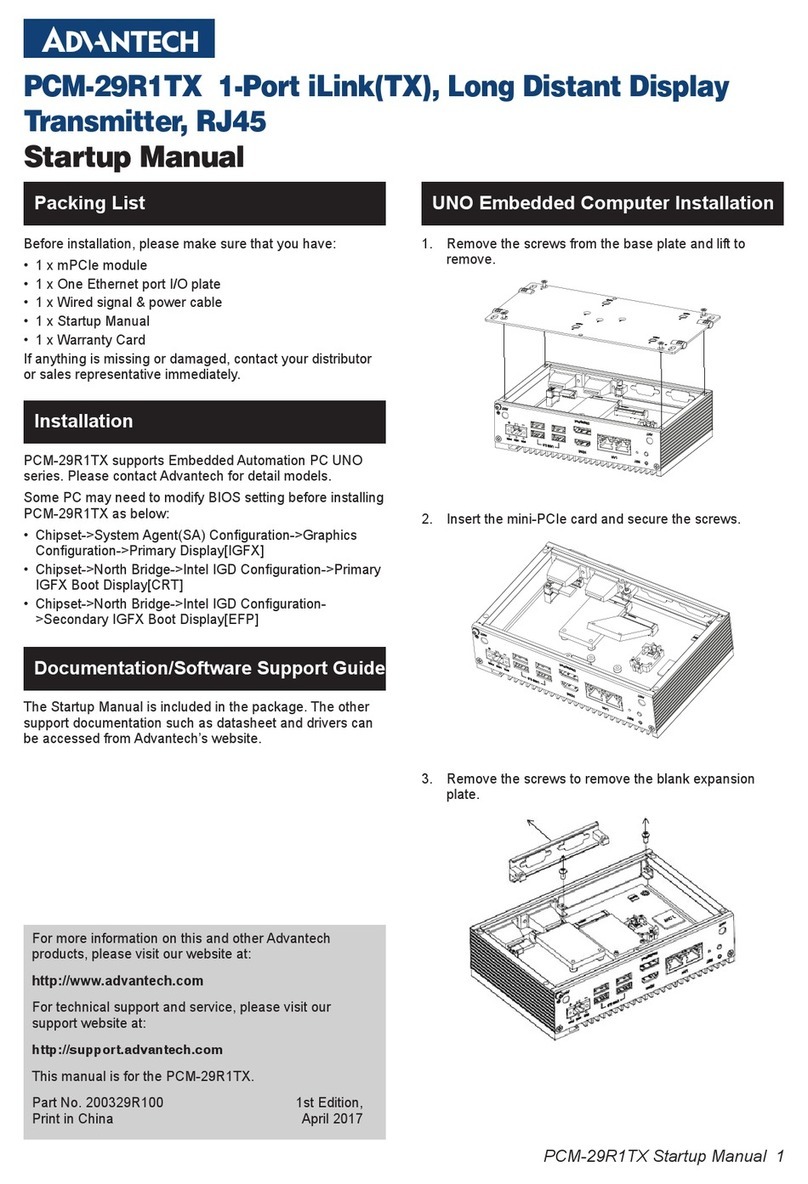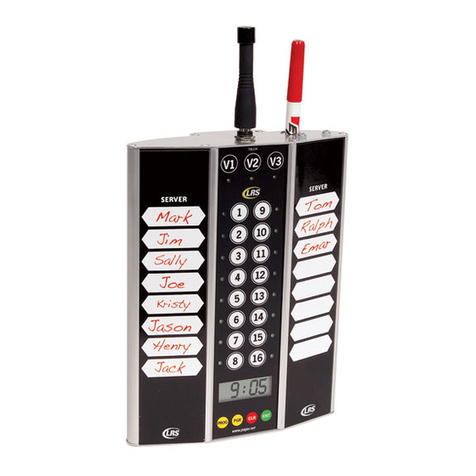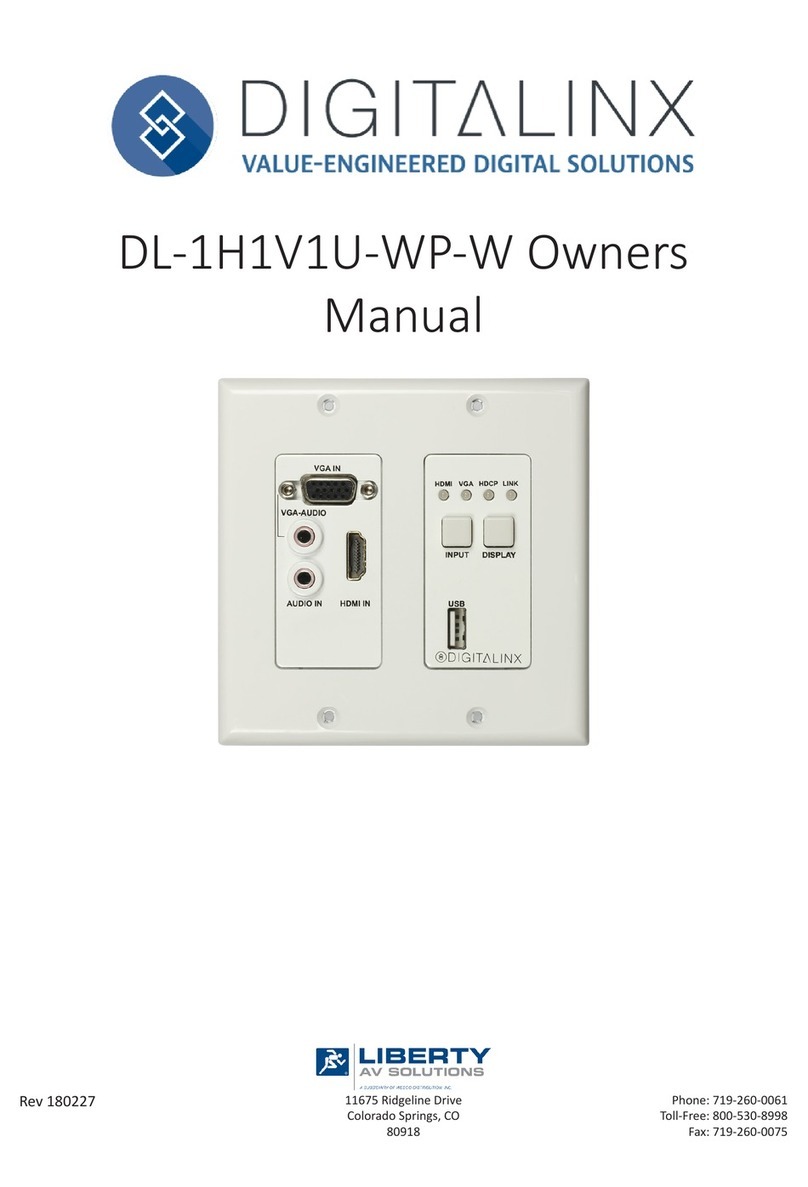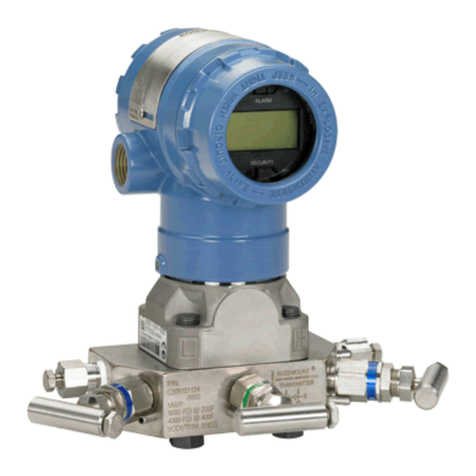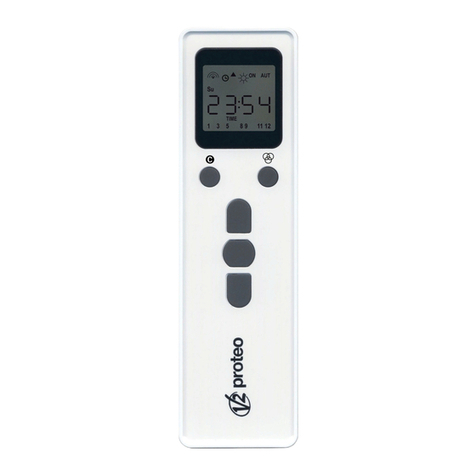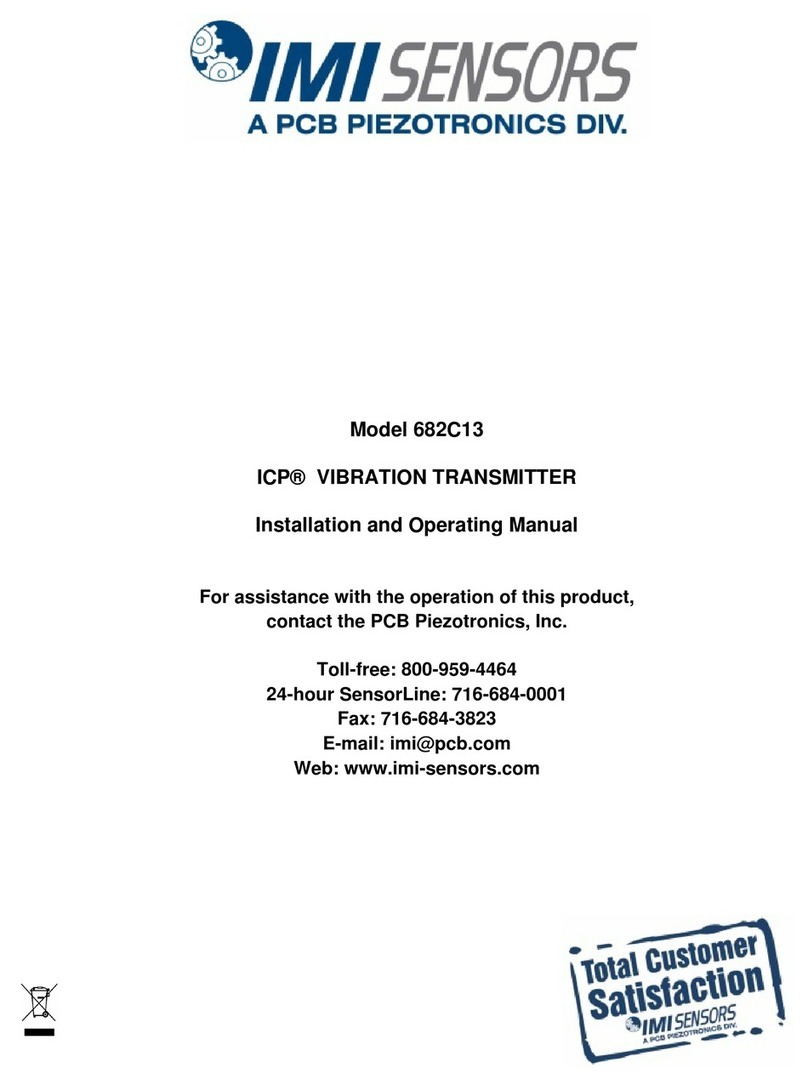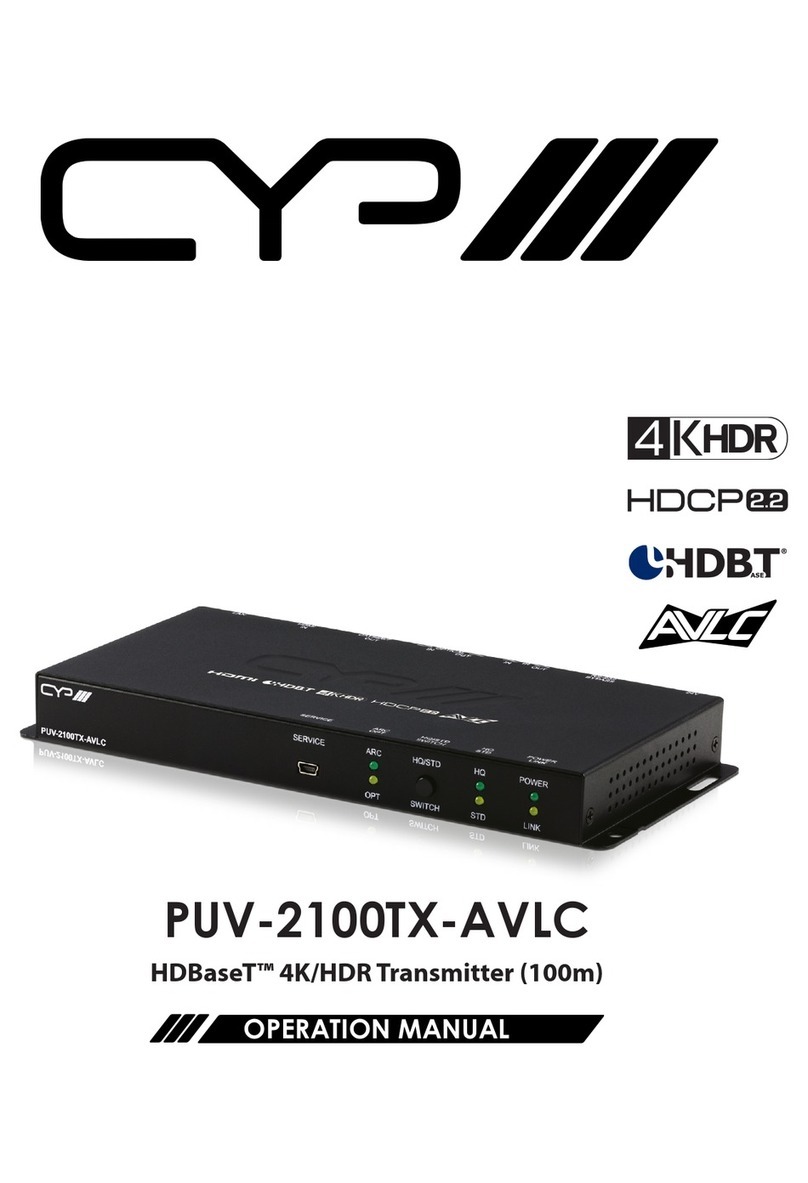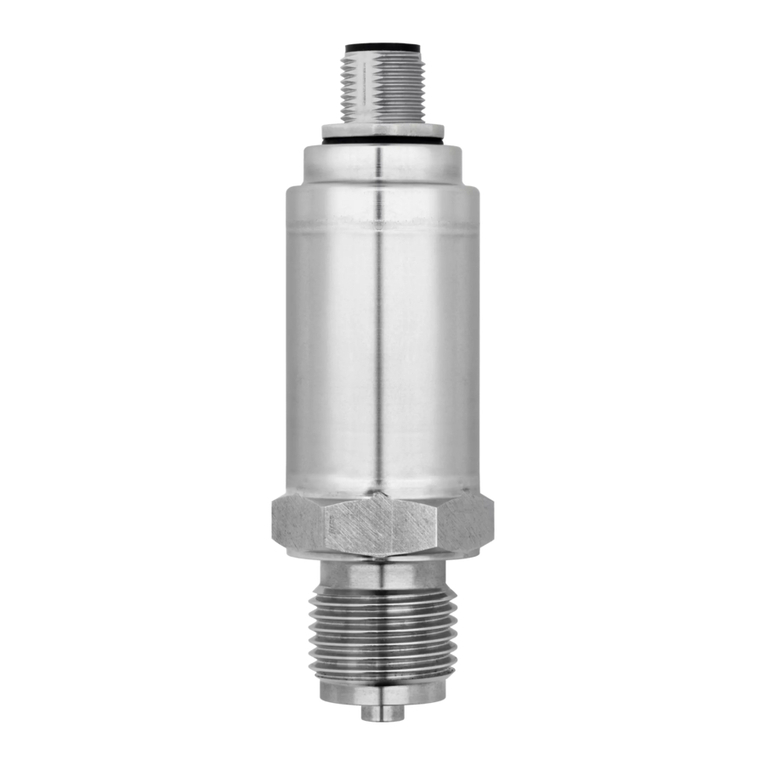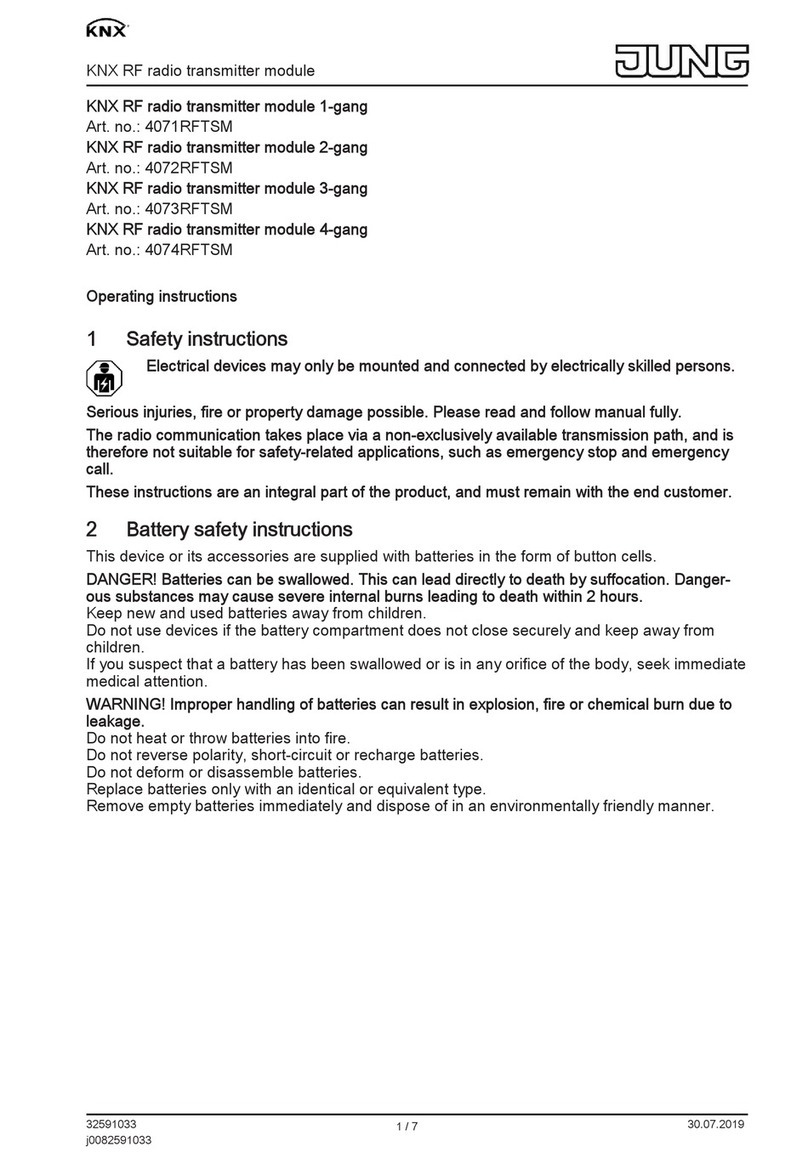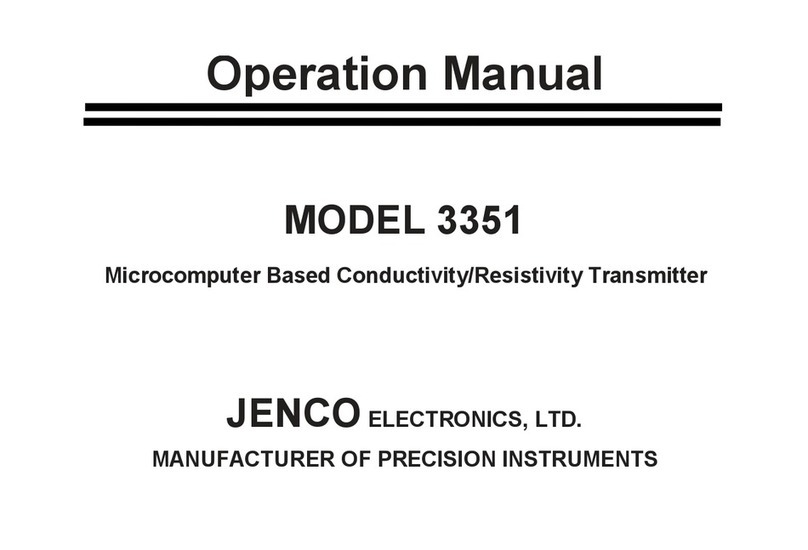Advantech SSPB-3000C User manual

INSTALLATION AND OPERATION MANUAL
200 WATT L-BAND TO C-BAND RACK-MOUNT
SOLID STATE TRANSMITTER
SSPB-3000C
PM 150-50N415-6G0, Rev. 1

SSBP-3000C
Page 1
WARRANTY
This ADVANTECH Advanced Microwave Technologies Inc. product is warranted against defects
in material and workmanship for a period of 2 years from date of shipment. During the warranty
period, ADVANTECH Advanced Microwave Technologies Inc. will, at its option, either repair or
replace the product, which proves to be defective.
To return a product for warranty or repair service, first request a Return Material Authorisation
(RMA) number by contacting ADVANTECH at:
Phone: (514) 420-0045 or Fax: (514) 420-0073
The product should be shipped to the following address, in the original shipping container (box),
with the prepaid shipping charges.
ADVANTECH Advanced Microwave Technologies Inc,
657 Orly Avenue
Dorval, Quebec
H9P 1G1
CANADA
Please indicate the RMA number on all shipping documentation.
Units shipped without a prior issued RMA, or not shipped in the original container, may be
rejected and returned at sender’s expense.
LIMITATIONS OF WARRANTY
ADVANTECH Advanced Microwave Technologies Inc. warrants this product to be free of
defects in materials and workmanship.
The foregoing warranty shall not apply to defects resulting from improper handling or abuse by the
purchaser, unauthorised modification, operating outside of the product’s environmental
specifications, improper installation or maintenance.
ADVANTECH Advanced Microwave Technologies Inc. shall not be liable for any direct,
indirect, special, incidental or consequential damages.

SSBP-3000C
Page 2
CONTENTS
1. SAFETY....................................................................................................................................................................6
2. GENERAL INFORMATION...............................................................................................................................8
2.1 INTRODUCTION........................................................................................................................................................8
2.2 ABOUT THIS MANUAL.............................................................................................................................................8
3. MAJOR COMPONENTS AND THEIR FUNCTION.....................................................................................10
3.1 L-BAND TO C-BAND UP-CONVERTER MODULE............................................................................................10
3.2 POWER AMPLIFIER MODULE ................................................................................................................................10
3.3 WAVEGUIDE ARM ASSEMBLY...............................................................................................................................11
3.4 10 MHZ OSCILLATOR .........................................................................................................................................11
3.5 MAIN CONTROLLER BOARD.................................................................................................................................11
3.5.1 Fault Detection and Indication............................................................................................................12
3.5.2 MUTE Control........................................................................................................................................12
3.6 POWER SUPPLY SYSTEM.......................................................................................................................................12
3.7 COOLING SYSTEM.................................................................................................................................................13
3.8 FRONT PANEL......................................................................................................................................................13
3.9 ELECTRICAL SPECIFICATIONS...............................................................................................................................17
4. INTERFACES.......................................................................................................................................................18
4.1 DISCRETE INTERFACE...........................................................................................................................................18
4.2 RS-232 INTERFACE.............................................................................................................................................19
4.3 RS-485 INTERFACE.............................................................................................................................................20
4.4 RF OUTPUT MONITOR INTERFACE.......................................................................................................................20
4.5 REDUNDANT INTERFACE......................................................................................................................................20
5. UNPACKING AND INSTALLATION...............................................................................................................22
5.1 INITIAL INSPECTION..............................................................................................................................................22
5.2 UNPACKING.........................................................................................................................................................22
5.3 INSTALLATION.....................................................................................................................................................22
5.3.1 Environmental and Adequate Ventilation Considerations..............................................................25
5.3.2 Mechanical Installation........................................................................................................................25
5.3.3 Electrical Connections..........................................................................................................................26
5.3.4 RF Connections......................................................................................................................................28
6. PRE-POWER AND SYSTEM CHECKOUT....................................................................................................29
6.1 PRE-POWER PROCEDURES ....................................................................................................................................29
6.2 OPERATIONAL SETTINGS VERIFICATION...............................................................................................................29
7. OPERATION.........................................................................................................................................................30
7.1 INTRODUCTION.....................................................................................................................................................30
7.2 SAFETY CONSIDERATIONS....................................................................................................................................30
7.3 BASIC OPERATING PROCEDURE............................................................................................................................30
7.4 FRONT PANEL OPERATION...................................................................................................................................31
7.5 DOWNLOADING THE SUPPLIED SOFTWARE...........................................................................................................32
7.6 USING THE SSPB SOFTWARE ..............................................................................................................................34
7.6.1 Using the RS-232 Interface...................................................................................................................34
8. MAINTENANCE..................................................................................................................................................40

SSBP-3000C
Page 3
8.1 PREVENTIVE MAINTENANCE.................................................................................................................................40
8.2 MECHANICAL PREVENTIVE MAINTENANCE..........................................................................................................40
8.3 COOLING FAN CHECK...........................................................................................................................................40
9. RS-485 SERIAL COMMUNICATION PROTOCOL....................................................................................41
9.1 FRAME STRUCTURE..............................................................................................................................................41
9.2 COMMANDS.........................................................................................................................................................42
9.3 RESPONSE TO COMMANDS FROM SLAVE TO MASTER...........................................................................................43
9.3.1 Condition Status Response...................................................................................................................43
9.3.2 Read Identification Response...............................................................................................................43
9.3.3 Read Frequency Range Response........................................................................................................44
9.3.4 Read Frequency Set Response.............................................................................................................44
9.3.5 Unit Status and Position Response.....................................................................................................45
9.3.6 Read Frequency Shift Response...........................................................................................................45
10. PACKING LIST....................................................................................................................................................46
11. APPENDIX A: SAFETY AND EMC COMPLIANCE....................................................................................48

SSBP-3000C
Page 4
FIGURES
FIGURE 1: PRODUCT OUTLINE.........................................................................................................9
FIGURE 2: SSPB BLOCK DIAGRAM ..............................................................................................14
FIGURE 3: FRONT PANEL ASSEMBLY ............................................................................................16
FIGURE 4: 1:1 REDUNDANT SYSTEM.............................................................................................21
FIGURE 5: CONNECTORS LOCATION ON FRONT AND BACK PANELS .............................................24
FIGURE 6: FRONT PANEL SEQUENCE ............................................................................................33
FIGURE7: RS-232 COMMUNICATION VIA HYPERTERMINAL.........................................................35
FIGURE 8: HELP FUNCTION IN HYPERTERMINAL...........................................................................37
FIGURE 9: REDUNDANT SYSTEM (REAR VIEW)..............................................................................49
FIGURE 10: REDUNDANT SYSTEM (LATERAL RIGHT VIEW).............................................................50
FIGURE 11: REDUNDANT SYSTEM (LATERAL LEFT VIEW)...............................................................51
FIGURE 12: REDUNDANT SYSTEM (TOP VIEW)..............................................................................52
FIGURE 13: RS-232 COMMUNICATION VIA HYPERTERMINAL FOR REDUNDANT SYSTEM..............53
FIGURE 14: PROPOSED GRAPHIC USER INTERFACE FOR A REDUNDANT SYSTEM BASED ON RS-485
PACKET PROTOCOL...............................................................................................................54

SSBP-3000C
Page 5
TABLES
TABLE 1: FRONT PANEL CONTROLS AND INDICATIONS ................................................15
TABLE 2: ELECTRICAL SPECIFICATIONS............................................................................17
TABLE 3: DISCRETE INTERFACE (J3) RELAY –PIN ASSIGNMENTS...............................19
TABLE 4: RS-232 SERIAL INTERFACE (J2) RS232 –PIN ASSIGNMENTS.........................19
TABLE 5: RS-485 SERIAL INTERFACE (J12) RS485 –PIN ASSIGNMENTS.......................20
TABLE 6: CONNECTORS.........................................................................................................23
TABLE 7: ENVIRONMENTAL CONDITIONS .........................................................................25
TABLE 8: SERIAL INTERFACE CONNECTION INFORMATION RS-232............................27
TABLE 9: POWER REQUIREMENTS.......................................................................................28
TABLE 10: AC LINE (J5) CONNECTOR –PIN ASSIGNMENTS............................................28
TABLE 11: RS-232 MENU ITEM DEFINITION........................................................................36
TABLE 12: COMPUTER TERMINAL COMMANDS FOR RS-232 INTERFACE ...................38
TABLE 13: COMMAND FRAME STRUCTURE.......................................................................42
TABLE 14: RESPONSE FRAME STRUCTURE........................................................................43
TABLE 15: READ IDENTIFICATION RESPONSE..................................................................43
TABLE 16: READ FREQUENCY RANGE RESPONSE ...........................................................44
TABLE 17: READ FREQUENCY SET RESPONSE..................................................................44
TABLE 18: UNIT STATUS AND POSITION RESPONSE........................................................45
TABLE 19: READ FREQUENCY SHIFT RESPONSE..............................................................45
TABLE 20: PACKING LIST.......................................................................................................46
TABLE 21: REDUNDANCY KIT...............................................................................................47

SSBP-3000C
Page 6
1. SAFETY
To prevent the risk of injury to personnel or loss related to equipment malfunction, ADVANTECH
uses the following symbols throughout this document to indicate safety-related information.
For your own safety, read the following carefully BEFORE operating this equipment!
---------------------------------------------------- WARNING --------------------------------------------
--
When supplying power to this equipment, verify that the power cable (not supplied) has the correct
pin assignment as given by TABLE 10 at page 28. Connect the cable to a properly grounded 3-pin
power outlet. Also connect a ground strap between the station’s ground bus and the ground screw
on the vertical rack. If power is supplied without grounding the equipment, there is a risk of
receiving a severe or fatal electric shock. In the context of this document any voltage that is lethal
is viewed as ‘High Voltage’. The prime power potential of 180-264 VAC applied to the
equipment is known to cause injury or death.
--------------------------------------------------- WARNING ---------------------------------------------
--
The operator cannot repair this equipment. DO NOT attempt to remove the transmitter
cover or disassemble the internal components.Only qualified service technicians should
service the transmitter. There are high-voltage parts within the unit, which present a risk of severe
injury to the untrained personnel. In addition, there is a risk of damaging the delicate components.
--------------------------------------------------- WARNING ---------------------------------------------
--
ALWAYS TERMINATE THE RF OUTPUT WAVEGUIDE PORT OF THE
TRANSMITTER WITH A RF LOAD CAPABLE OF DISSIPATING FULL CW RF
POWER. ALSO, TERMINATE THE IF INPUT CONNECTOR TO AVOID THE
POSSIBILITY OF THE UNIT BEING DRIVEN BY STRAY LEAKAGE SIGNALS.
WARNING:
This indicates a hazardous procedure that may result in serious injury or death
if not performed properly.CAUTION: This indicates a hazardous procedure that may result in light-to-
severe
injury or loss related to equipment malfunction, if proper precautions are not taken.

SSBP-3000C
Page 7
Incorporate the terminations prior to applying prime power to the transmitter. This procedure
prevents self-oscillation and irradiation from and into the local environment. If the IF input of the
transmitter is not connected to a RF source, the unit may go into a self-induced mode and generate
high levels of RF energy. Destruction caused by an excessive load voltage standing wave ratio
(VSWR) will void the warranty.
--------------------------------------------------- WARNING ---------------------------------------------
--
DO NOT LOOK INTO THE RF OUTPUT PORT OF THE POWERED TRANSMITTER!
Handle the unit with extreme care. Although the levels of microwave radiation do not induce
immediate physical discomfort in most individuals, the levels may be sufficiently high to induce
long-term effects. The eyes are the most vulnerable parts of the body.
The maximum permissible levels of RF exposure are quite low compared to the power levels
emitted by the transmitters built by Advantech (e.g. less than 10 mW versus 10 to 500 W for the
units). The maximum permissible levels are currently being studied by a number of organisations.
In the past, the U.S. Safety Code established a dosage rate of 10 mW/cm2. Currently, consideration
is being given to reduce the permissible level to 1 mW/cm2in the United States, as has been the
case for several European countries.
---------------------------------------------------- CAUTION --------------------------------------------
---
THE TRANSMITTER UNIT IS HEAVY! TWO INDIVIDUALS OR A LIFTING DEVICE
MUST BE USED TO LIFT AND MOVE THE UNIT. There is a risk of back injury, if carried
or lifted by a single person.
In addition to this Section, included by reference are the following pertinent sections of the
International Standard IEC-215, ‘Safety requirements for radio transmitting equipment’:
Appendix D, ‘GUIDANCE ON ASSESSING THE COMPETENCE OF PERSONNEL FOR
DESIGNATION AS SKILLED’ and also Sub-clause 3.1 of the Standard.
Appendix E, ‘GUIDANCE ON SAFETY PRECAUTIONS TO BE OBSERVED BY PERSONNEL
WORKING ON RADIO TRANSMITTING EQUIPMENT’ and also Sub-clauses 3.2, 3.7 and 22.1
of the Standard.

SSBP-3000C
Page 8
2. GENERAL INFORMATION
2.1 INTRODUCTION
The ARMU-LC200-BRN , part of the SSPB-3000C family, is a 200-Watt L-Band to C-Band Solid
State Up-Converter (SSPB) designed for satellite up-link communication systems. The SSPB is an
indoor unit conceived for mounting into a standard 19-inch rack. The RF output should be
connected to an antenna using a waveguide system. The product outline of the unit is shown in
Figure 1 at page 9.
Built-in monitor and control features indicate the current status of the SSPB unit and provide fault
detection and protection when operating outside normal operating conditions. The SSPB also
allows the user access to the monitor and control functions by using the Relay (Discrete) Interface,
or the RS-232 and the RS-485 Serial Interfaces.
The SSPB unit can be combined with another unit to form a 1:1 redundant system (see Figure 4 at
page 21). A redundancy kit is available as an option to build a 1:1 redundant system.
2.2 ABOUT THIS MANUAL
This manual contains information that describes the installation, operation and maintenance
procedures for the 200-Watt C-Band rack-mount SSPB Up-Converter. Warnings appear at the
appropriate points to caution all users of the potential RF and high-voltage hazards.
For a safe and versatile operation, please read carefully all of the information provided by this
manual BEFORE using this equipment!
ADVANTECH Advanced Microwave Technologies, Inc. has prepared this manual for use as a
guide for the proper installation, operation and maintenance of the ADVANTECH Solid State
High Power Up-Converters. The drawings, specifications and information contained herein
are the property of ADVANTECH Advanced Microwave Technologies, Inc. Unauthorised use or
disclosure of these drawings, specifications and information is strictly prohibited. These
documents shall not be reproduced, copied or used in whole or in part as the basis for
manufacturing or sale of the equipment or software programs without the prior written consent
of ADVANTECH Advanced Microwave Technologies, Inc.

SSBP-3000C
Page 9
Figure 1:Product Outline

SSBP-3000C
Page 10
3. MAJOR COMPONENTS AND THEIR FUNCTION
This Section describes the major components and their functions within the SSPB unit. The SSPB
incorporates an L-Band to C-Band Up-Converter module, a Power Amplifier module, a
Waveguide Arm assembly, a 10 MHz oscillator, a Main Controller board, a Power supply
subsystem, a Current Sensor, a Cooling system and a Front Panel assembly. The remote
monitoring and control of all major parameters is possible via the RS-232 and RS-485 interfaces.
3.1 L-BAND TO C-BAND UP-CONVERTER MODULE
The L/C-Band Up-Converter Module converts and amplifies the incoming L-Band signals into
the desired C-Band carrier signals.
The module has an internal synthesiser, which is fixed at 4900 MHz.
To control the output power level of the converter, an attenuator is used to provide the system gain
control.
The Up-Converter module has RS-485 communication to the Main Controller board. An additional
discrete signal is available at this module: the Alarm Up-Converter (output).
3.2 POWER AMPLIFIER MODULE
The Power Amplifier Module amplifies the RF C-Band signals from the L/C-Band Up-Converter
module over the frequency range of 5.850 GHz to 6.425 GHz. The power amplifier has a 60 dB
typical gain.
For monitoring, the power amplifier has an RS-485 interface, which connects to the main
controller board. Two additional discrete signals are available at this module: the Alarm PA
(output) and the Mute PA (input) for muting the Power Amplifier.
A temperature sensor is installed at the hot spot of the module to monitor the temperature. When
the hot spot temperature exceeds +85 ºC, a shutdown command is issued by the controller of the
module, in order to prevent the damage of the RF devices due to overheating.
The controller of the Power Amplifier also has the following functions:
1. Provides and removes the DC voltages to the GaAs FET devices within the module.
2. Sends a FAULT signal to the main controller board when detecting a fault.
The Power Amplifier will be in Mute mode if:
1. The Main Controller board sends a MUTE command to the PA module.
2. The hotspot temperature exceeds 85°C,

SSBP-3000C
Page 11
3. Any of the GaAs FET devices fails (current is out of range)
3.3 WAVEGUIDE ARM ASSEMBLY
The Waveguide Arm Assembly contains a forward power detector, a reverse power detector, a
RF isolator, an output power coupler, and a waveguide band-pass filter.
The forward power detector and the reverse power detector monitor the RF output power and the
reflected power level and sends these detected signals to a Digital Power Monitor module, that
converts these analogue signals into digital ones. The digital signals are sent to the Main
Controller board via an RS-485 serial interface.
The RF isolator provides VSWR protection at the SSPB RF output port. The VSWR at the isolator
output is 1.25:1, minimum. The termination load of the isolator is capable of absorbing full
reflective power. A CPR-137 grooved waveguide flange is the output of the unit.
3.4 10 MHZ OSCILLATOR
This circuit is used to generate a 10 MHz reference signal with a high stability of 3 x 10-8typical,
which is required by the Up-Converter module. The 10 MHz signal is provided to the Up-
Converter module via a coaxial cable.
3.5 MAIN CONTROLLER BOARD
The Main Controller Board contains a microprocessor controller that performs all of monitoring
and the control, input/output communication and the decision-making. The main controller board
provides:
1. Fault detection and indication from each part of the unit
2. Mute control and indication
3. Forward RF power detection and indication
4. Reflected power detection and indication
5. Power On indication (front panel LED)
6. Redundancy control (1:1 redundant system)
7. Frequency control
8. Unit gain control (attenuation setting).
9. Discrete Interface, RS-232 and RS-485 Serial Interfaces

SSBP-3000C
Page 12
3.5.1 FAULT DETECTION AND INDICATION
The unit will automatically go into a shutdown mode and send a message to all of the external
interfaces when any one of the following occurs:
1. The local oscillator within an up-converter module is out of lock.
2. The hotspot temperature exceeds 85°C.
3. Any of the GaAs FET devices fails.
The SSPB continually monitors the internal temperature and the current consumption. It also has
an automatic shutdown feature to prevent operation at excessive temperatures. The unit will
automatically restart when the hotspot temperature falls below 65°C.
A thermal alarm may result from any one of the following conditions:
1. High ambient temperature (SSPB is designed to operate between 0°C and + 50 °C ambient).
2. Blockage at the air intake or exhaust vents.
3.5.2 MUTE CONTROL
The user can disable the RF output power remotely by:
1. Leaving unconnected pins 1 and 5 of the RELAY Interface connector.
2. Sending a mute command in terminal mode through the RS-232 interface.
3. Sending a mute command in packet mode through the RS-485 interface.
This feature is useful if the user wishes to perform a maintenance check or to check out the
transmission system.
3.6 POWER SUPPLY SYSTEM
The Power Supply Systemhas one input: 180-264 VAC. The power supply provides a +12 VDC
high current output to the following modules via relay K1 and the ON/OFF switch (see Figure 2 at
page 14):
1. Power amplifier module,
2. L/C-Band up-converter module,
3. Secondary power supply,
4. Varifan power supply,
5. 10 MHz oscillator,
6. Redundancy waveguide switch, (if working in the redundancy mode) and

SSBP-3000C
Page 13
7. Current sensor.
The main controller board also receives the +12 VDC low current from the power supply.
The main power supply operates from an 180 -264 VAC, 47-63 Hz power source.
The secondary power supply provides multiple outputs for operating the L-Band/C-Band up-
converter and the power amplifier modules.
To prevent unwanted noise from entering the SSPB, a line filter is connected between the AC input
connector and the main power supply. The overall typical power consumption, at the rated RF
output power, is approximately 400 Watts.
3.7 COOLING SYSTEM
The cooling system for the SSPB consists of four cooling fans. Two fans are mounted at the front
panel and the other two at the rear panel (see Figure 1 at page 9).
The Varifan power supplies provide + 48 VDC voltages (variable between 11 and 60 VDC,
temperature dependent voltages) for operating the four cooling fans. The Varifan power supplies
are configured for +12 VDC input voltage operation.
3.8 FRONT PANEL
The front panel provides for the user, LOCAL monitoring and control of the SSPB. The front
panel contains an ON/OFF circuit breaker, six pushbuttons, six LEDs and a vacuum florescent
display (VFD). TABLE 1 at page 15 lists and describes the front panel controls and indications.
Figure 3 at page 16 shows the front panel outline.

SSBP-3000C
Page 14
Figure 2: SSPB Block Diagram
HPA ASSEMBLY W/G ARM ASSEMBLY
TEMP
SENSOR
+12V,
-9V
+12V,
-9V
OUTPUT
POWER
DETECTOR
40 dB CIRCULATOR
LNA
CONTROLLER
&
POWER CONDITIONER BOARD
BPF
ISOLATOR
+12 V
FW_PWR
J1
RF IN
+ 12 V
RF_OUT
MON
MAIN CONTROLLER BOARD
MUTE_PA
RS-485_UC
ALM_PA
REDUND REDUND
RS-485
RELAY
RS-485
RELAY
RS-232 RS-232
MAIN
POWER
SUPPLY
J5
AC LINE
- 9 V
COOLING
FANS
(4)
CURRENT
SENSOR
CS
+12 V
+12 V
RV_PWR
REFLECTED
POWER
DETECTOR
30 dB
oC
THERMISTOR
DIGITAL POWER
MONITOR
+12 V
RS-485_PM
HPA
L
G
NLN
L
N
GND
- 9 V
RS-485_PA
TH
+12 V
SECONDARY
POWER
SUPPLY
VARIFAN
POWER
SUPPLY
TH
48 V (0 ... 64 V)
+12 V
+12 V
+5V
GND
UP
DOWN
LEFT
RIGHT
ENTER
CLEAR
FRONT PANEL BUTTONS
FRONT PANEL PCB
FRONT PANEL DISPLAY
10 MHz REFERENCE
OSCILLATOR
10 MHz
SPLITTER
+12 V
GND
L-BAND TO C-BAND UP-CONVERTER
AMP
BPF
RS-485_UC
ALARM_UC
+12 V
VVA MIXER
PLL
LO
CONTROLLER
AMP
GND
GND
-9 V
REF
10 MHz
OUT
50
50
50
ALARM_UC
CIRCUIT
BREAKER

SSBP-3000C
Page 15
TABLE 1:FRONT PANEL CONTROLS AND INDICATIONS
Control/display Function
ENTER Select menu line, select item for modification or end of item’s
modification, save new value or return to previous item.
CLEAR Return to previous item without saving any value.
UP arrow Move to previous menu item or modify selected parameter.
DOWN arrow Move to next menu item or modify selected parameter.
LEFT arrow Select character left from the cursor for modification.
RIGHT arrow Select character right from the cursor for modification.
PWR ON LED Blue LED. When lit, indicates that power is applied to the Main
Controller Board of the unit.
RF ON LED Green LED. When lit, indicates that the unit is in RF ON (NOT MUTE)
state.
REMOTE
Green LED. When lit, indicates that the unit is in REMOTE
CONTROL (from PC) as opposed to LOCAL control (from its front
panel). This situation is not applicable for these units which do not
discriminate between LOCAL and REMOTE control. Consequently this
LED will be always dark.
MUTE LED Yellow LED. When lit, indicates that the RF circuits are disabled and
no RF output power is delivered.
ALARM LED Yellow LED. When lit, indicates a temperature ALARM situation: the
hot spot temperature of the unit is over 75 °C but under 80 °C. The unit
is still functional but with some degraded performance.
STATUS LEDs
FAULT LED Red LED. When lit, indicates the failure of the unit. The unit is not
functional.
AUTO LED Blue LED. When lit, indicates that the redundancy control is in AUTO
mode (if the ON-LINE unit failed, the switching of the STAND-BY unit
to the antenna is performed automatically).
ONLINE LED Green LED. When lit, indicates that the unit is in ONLINE (switched to
the antenna) in the redundant configuration.
REDUNDANT LEDs
STBY LED Yellow LED. When lit, indicates that the unit is in STAND-By
(switched to the dummy load) in the redundant configuration.
Vacuum Fluorescent
Display (VFD) Displays 2 lines of 20 alphanumerical characters. The first line shows
the output power level of the SSPB and the gain. The second line shows
the selected menu type or the value of the selected parameter. Figure 6
at page 33 shows all of the menus used by the SSPB.

SSBP-3000C
Page 16
Figure 3: Front Panel Assembly

SSBP-3000C
Page 17
3.9 ELECTRICAL SPECIFICATIONS
The electrical specifications for the SSPB are listed in TABLE 2.
TABLE 2:ELECTRICAL SPECIFICATIONS
Input Frequency 950 -1525 MHz
L-Band Input Impedance 50 Ω
Input VSWR ≤1.5 : 1
Linear Gain 73 dB ±1 dB, @ 6.150 GHz and +23 °C
L-Band Input Operational Level -21 … -11 dBm
Frequency Stability 3 x 10–8, typical
RF Output Power 1 dB Compression (P1dB) + 52 dBm, min
Third Order Intermodulation ≤-26 dBc (2 equal tones, 5 MHz apart, each
at -6 dB output back-off from P1dB
≤-36 dBc (2 equal tones, 5 MHz apart, each
at -10 dB output back-off from P1dB
RF Output Frequency Range 5.850 -6.425 GHz (C -Band)
Spurious at P1dB In-band
Out-of-band -50 dBc, max
-50 dBc, max
RF Output VSWR ≤1.25 : 1
Gain Flatness: Over 36 MHz
Over 2 MHz 2 dB, p-p, max
0.5 dB, p-p, max
Gain Variation Over Temperature 2 dB, p-p
Phase Noise
Offset 100 Hz
1 kHz
10 kHz
≥100 kHz
C-Band Single Side Band Phase Noise
-60 dBc/Hz
-70 dBc/Hz
-80 dBc/Hz
-90 dBc/Hz
Operating Temperature 0oC to 50 oC

SSBP-3000C
Page 18
4. INTERFACES
The SSPB provides four user interfaces that could be used to connect to several optional external
devices. The interfaces for this model are listed below:
1. Discrete Interface (J3): This interface offers the essential monitoring and control of the
SSPB by discrete signals.
2. RS-232 Interface: This interface offers to the operator the essential monitoring and control of
the SSPB using a personal computer equipped with any terminal software.
3. RS-485 Interface: This interface offers the complete monitoring and control of the SSPB and
provides the communication and remote control through the RS-485 serial communication port
in packet mode.
4. RF Output Monitor Interface: This interface provides a sample of the output power of the
unit through a 40-dB coupler.
4.1 DISCRETE INTERFACE
The Discrete Interface is located at connector (J3) on the rear panel of the SSPB (see Figure 5 at
page 24). This connector is a female, 15-pin DB-type with a pin assignment as shown in
TABLE 3 at page 19.
Pins 2, 3 and 4 of connector (J3) are of Form-A relay type outputs that provide the user an
indication informing the status of the SSPB.
Pin 1 of connector (J3) RELAY is the mute control input, allowing the user to mute or un-mute the
RF output of the SSPB.
CAUTION: If pin 1 is not connected to pin 5, the unit will remain disabled (mute).

SSBP-3000C
Page 19
TABLE 3:DISCRETE INTERFACE (J3) RELAY –PIN ASSIGNMENTS
Pin Description
1
TX_MUTE (External MUTE Command)
If pin 1 (MUTE COMMAND) is connected to pin 5 (MUTE COMMON) the SSPB
is enabled (RF ON).
If pin 1 (MUTE COMMAND) is not connected to pin 5 (MUTE_COMMON) the
unit is disabled (MUTE).
2 TX_AL_NC (FAULT-NC) Normal closed contact of TX_ALARM (FAULT)
Relay. If closed to pin 2 (TX_AL_COM) indicates the FAULT state of the unit.
3 TX_AL_COM (FAULT-COM) FAULT relay common
4 TX_AL_ NO (FAULT-NO) Normal open contact of TX_ALARM (FAULT) Relay.
If open relative to pin 2 (TX_AL_COM) indicates the FAULT state of the unit.
5 MUTE_COMMON (common)
6-9 N/C (not connected)
4.2 RS-232 INTERFACE
This serial communication interface offers to the operator the essential monitoring and control of
the SSPB using any PC terminal software. An IBM compatible personal computer can be
connected to this port. This interface is located on the back panel of the SSPB (see Figure 5 at
page 24). The mounting connector is a female, 9-pin DB-type with a pin assignment as shown in
TABLE 4.
TABLE 4:RS-232 SERIAL INTERFACE (J2) RS232 –PIN ASSIGNMENTS
Name Type Pin # Designation
--1, 9 Not used
TX-232 Serial port (output) 2 Serial transmit TX
RX-232 Serial port (input) 3 Serial receive RX
RS-232_C Serial port (common) 5 System common
-Jumper 4 to 6 -
-Jumper 7 to 8 -
Table of contents
Other Advantech Transmitter manuals
Popular Transmitter manuals by other brands
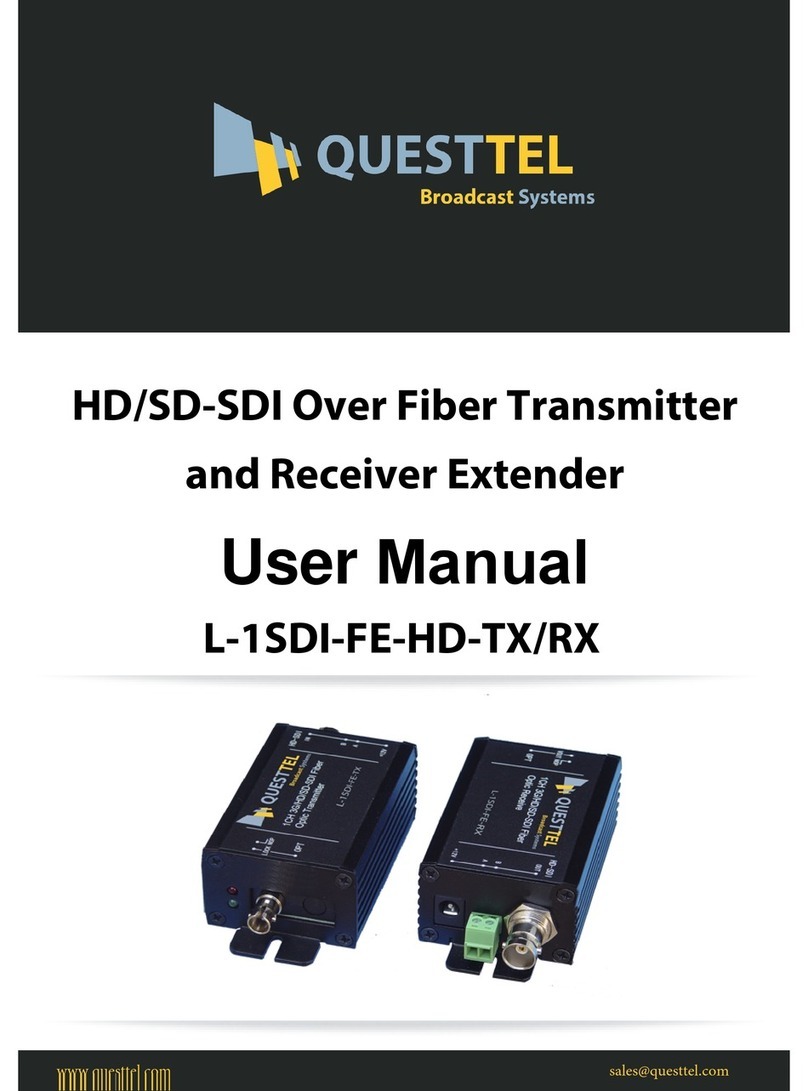
Questtel
Questtel L-1SDI-FE-HD-TX user manual
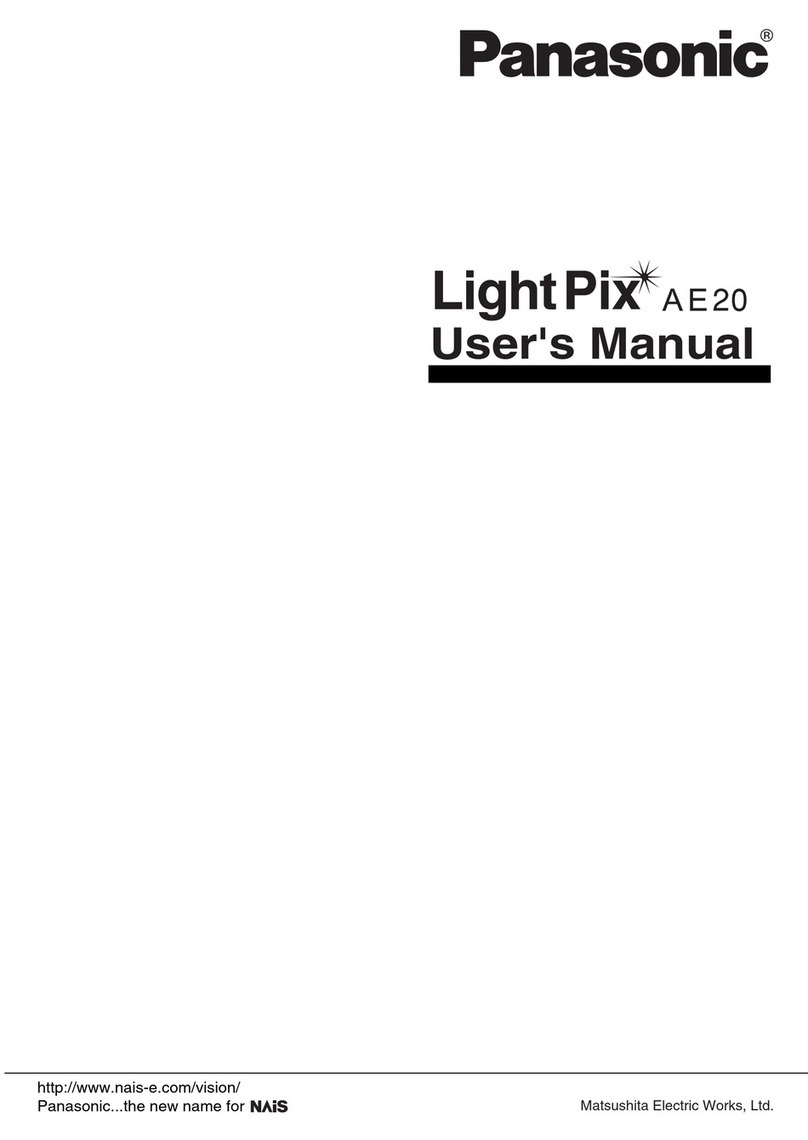
Panasonic
Panasonic LightPix AE20 user manual
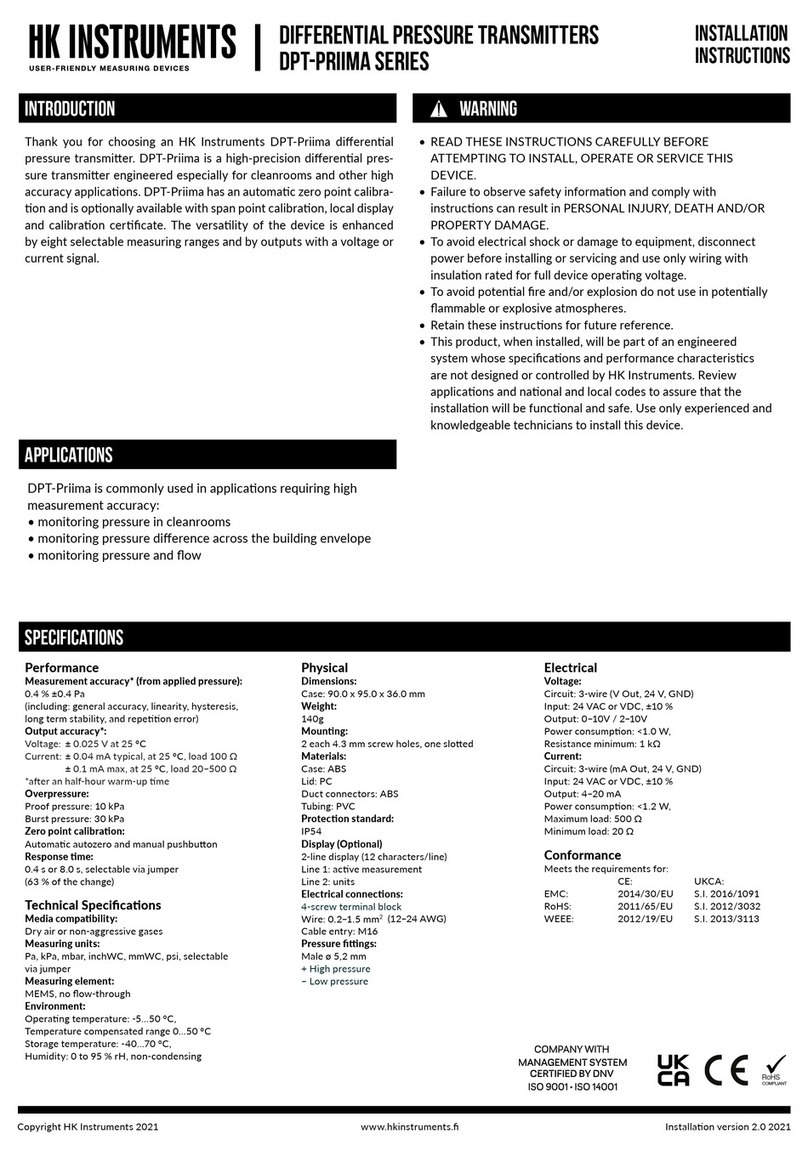
HK Instruments
HK Instruments DPT-Priima Series installation instructions
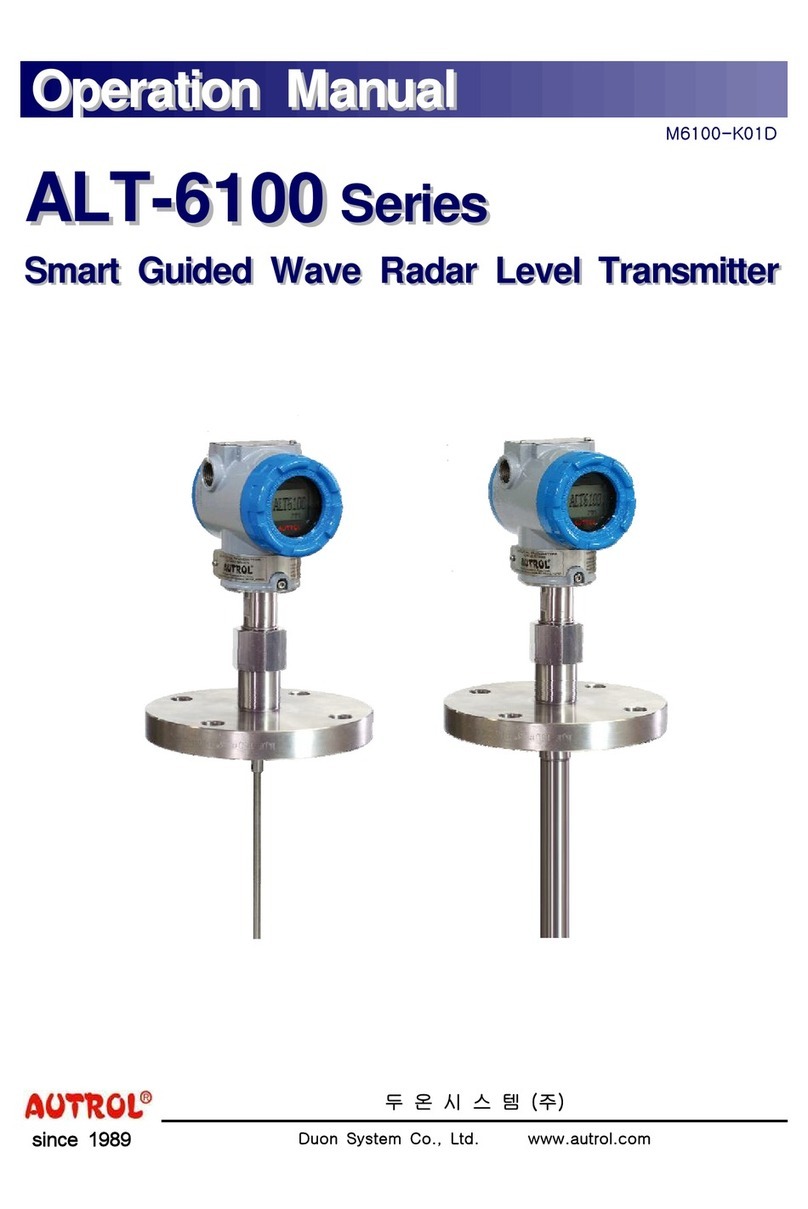
Autrol
Autrol ALT-6100 Series Operation manual
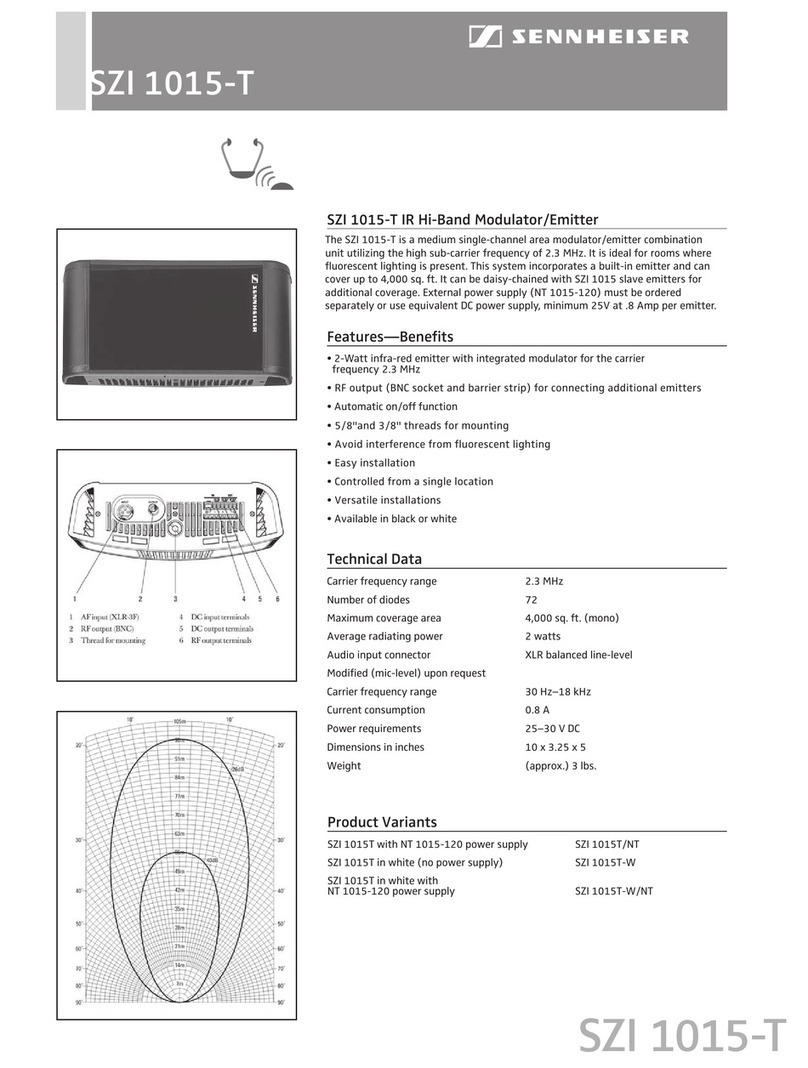
Sennheiser
Sennheiser SZI 1015-T specification
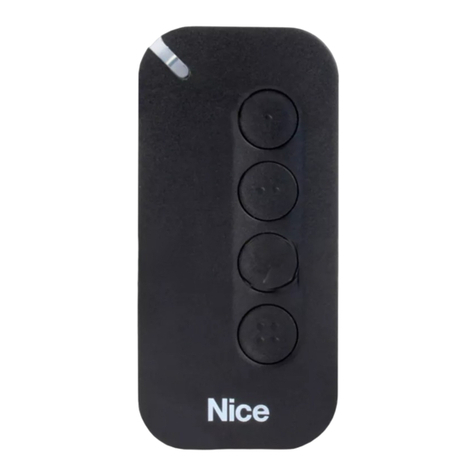
Nice
Nice MYGO2BD Instructions and warnings for installation and use
